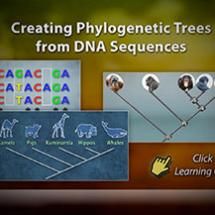Have you ever gazed at a sprawling tree and marveled at its complex branching structure? Those branches tell tales of resilience, adaptation, and survival. In a similar vein, phylogenetic trees, constructed from the intricate sequences of DNA, reveal the evolutionary relationships among organisms, providing insight into their shared ancestry. This guide will explore the fascinating world of creating phylogenetic trees from DNA sequences, unraveling the methodologies and techniques involved while piquing your curiosity about the depths of evolutionary biology.
Understanding Phylogenetics
The branch of biology that deals with evolutionary relationships is known as phylogenetics. At its essence, phylogenetics explores how species are interconnected through common ancestors, much like how a family tree traces lineage. The beauty of this field lies in its ability to map out the evolutionary history of life on Earth, giving us a deeper understanding of biodiversity and the mechanisms of evolution.
Phylogenetic trees are visual representations of these relationships, depicting how different species diverge over time. The tree structure consists of nodes (which represent common ancestors) and branches (indicating evolutionary pathways). But how does one construct these trees from something as microscopic as DNA sequences?
The Importance of DNA Sequences
DNA, the molecule that carries genetic information, serves as a blueprint for all living organisms. Each species has a unique DNA sequence, yet there are striking similarities among related species. By analyzing these sequences, scientists can infer evolutionary relationships. This exploration is vital not just for academic understanding but also for various practical applications, such as conservation efforts and medical research.
When embarking on the journey to create a phylogenetic tree, one begins with the selection of an appropriate DNA sequence. This could be mitochondrial DNA, nuclear DNA, or ribosomal RNA sequences, depending on the organisms in question and the evolutionary questions being posed. Mitochondrial DNA, for instance, is often used in animal studies due to its relatively rapid rate of evolution, allowing for the differentiation of closely related species.
Data Collection: The First Step
The initial step in crafting a phylogenetic tree involves acquiring DNA sequences. This can be done through various techniques, including polymerase chain reaction (PCR), which amplifies specific DNA segments, and sequencing methods, such as Sanger sequencing or next-generation sequencing (NGS). With advancements in technology, sequencing has become more efficient and cost-effective, allowing for the analysis of numerous samples simultaneously.
Once the DNA sequences are obtained, they must be aligned. Sequence alignment ensures that homologous sequences (those that are derived from a common ancestor) are compared accurately. There are several tools available for this purpose, such as Clustal Omega and MUSCLE. These software programs organize the sequences, highlighting similarities and differences, and providing a solid foundation for constructing the phylogenetic tree.
Choosing the Right Model
After aligning the sequences, the next step is selecting a suitable model of evolution. This model describes how DNA changes over time and is critical for accurate tree construction. Different models account for various evolutionary processes, such as substitutions, insertions, and deletions of nucleotides. Common models include the Kimura two-parameter model and the General Time Reversible (GTR) model. Understanding the biological context of the organisms involved is essential for choosing the most appropriate model.
Constructing the Tree
With aligned sequences and a chosen model in hand, researchers can now construct the phylogenetic tree. There are various algorithms to accomplish this, including:
- Neighbor-Joining: A distance-based method that builds the tree from a matrix of pairwise differences between sequences.
- Maximum Likelihood: This approach evaluates different tree topologies based on the likelihood of the observed data, given a specific model of evolution. It is statistically rigorous but computationally intensive.
- Bayesian Inference: A probabilistic method that incorporates prior information alongside the current data, yielding a posterior probability distribution for the tree topology.
After executing these algorithms, researchers often visualize the tree using software such as Figtree or iTOL. The resulting tree not only illustrates the relationships among the species but also conveys information about evolutionary history, divergences, and even the timing of speciation events.
Interpreting the Phylogenetic Tree
Once the phylogenetic tree has been constructed, the journey doesn’t end there. Interpreting the tree is crucial for understanding the results. Key aspects to analyze include:
- Branch Lengths: These may indicate the amount of evolutionary change or the time elapsed since divergence.
- Node Support: Statistical supports, such as bootstrap values, assess the reliability of the inferred relationships.
- Clades: Identifying monophyletic groups (clades) helps to understand shared ancestry among organisms.
Applications and Future Directions
The outcomes from phylogenetic analyses have profound implications beyond academic inquiry. Conservation biology relies on phylogenetic insights to prioritize species for preservation efforts. In medicine, phylogenetics assists in tracking the evolution of pathogens, informing vaccine development and public health responses. As technology continues to advance, the integration of genomic data into phylogenetic studies promises to unveil even more intricate relationships among life forms.
As you immerse yourself in the world of phylogenetic trees and DNA sequences, remember that these diagrams represent more than just data; they encapsulate the vast narrative of life on Earth. They remind us of the interconnectedness of all living beings and the journey of evolution that continues to unfold. Whether you’re embarking on your own research or simply seeking to understand the natural world better, the study of phylogenetics is an exciting frontier, waiting to be explored.
